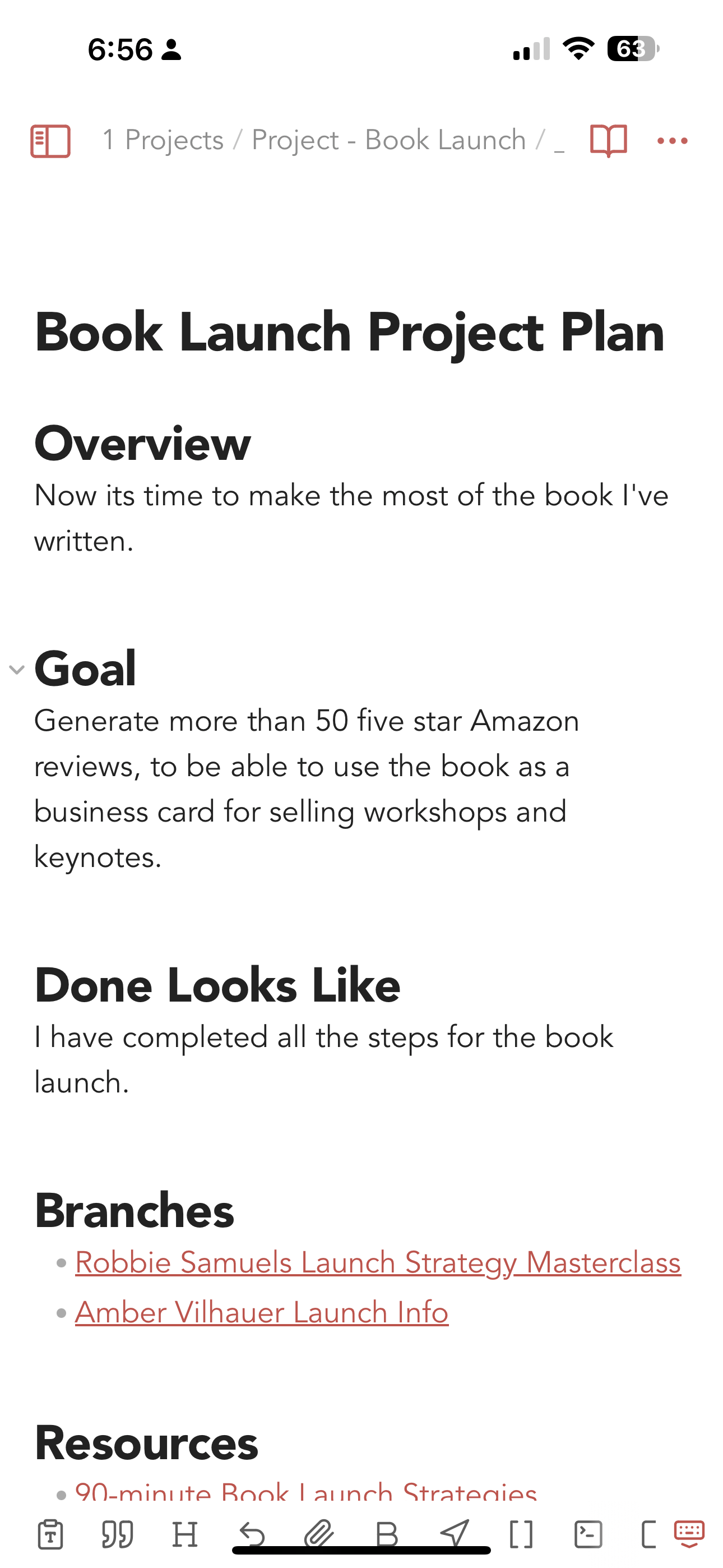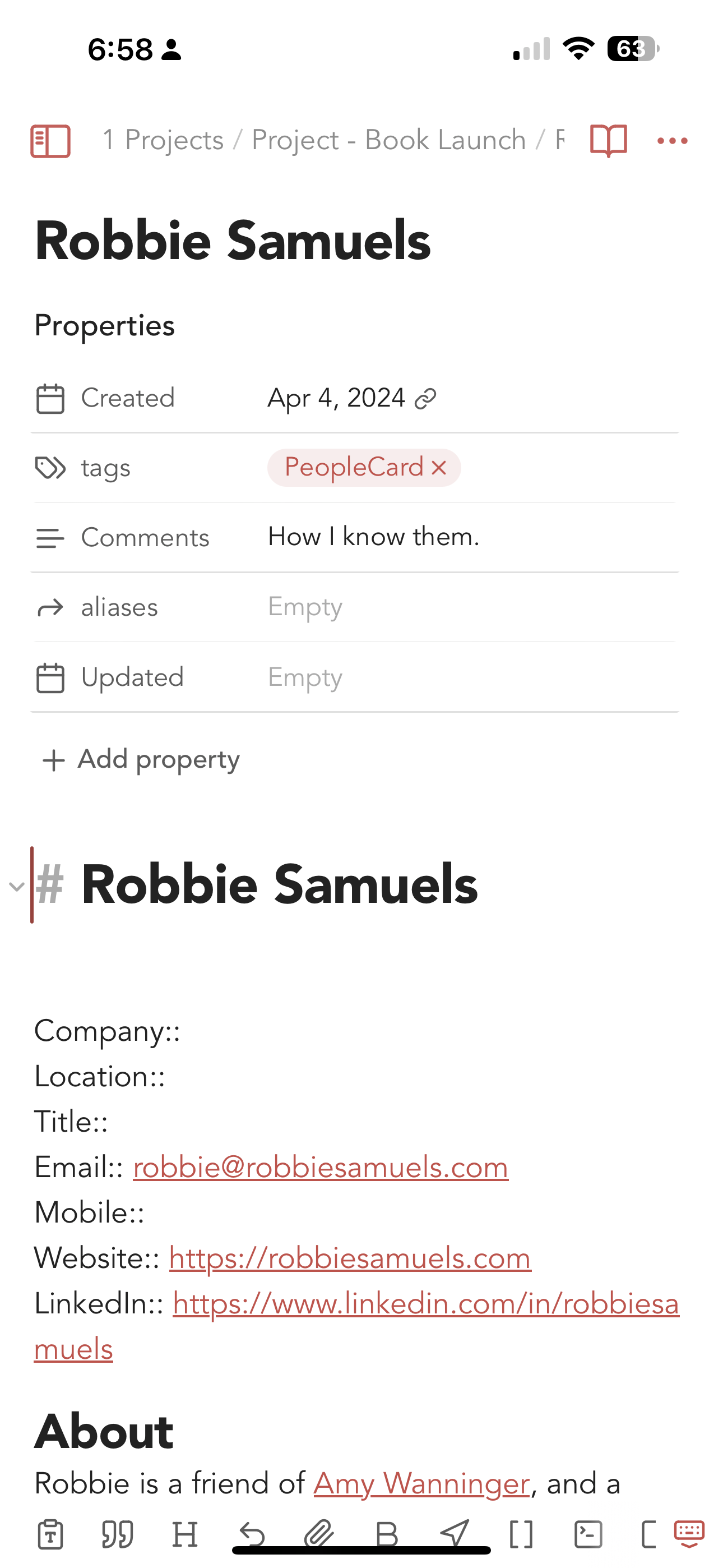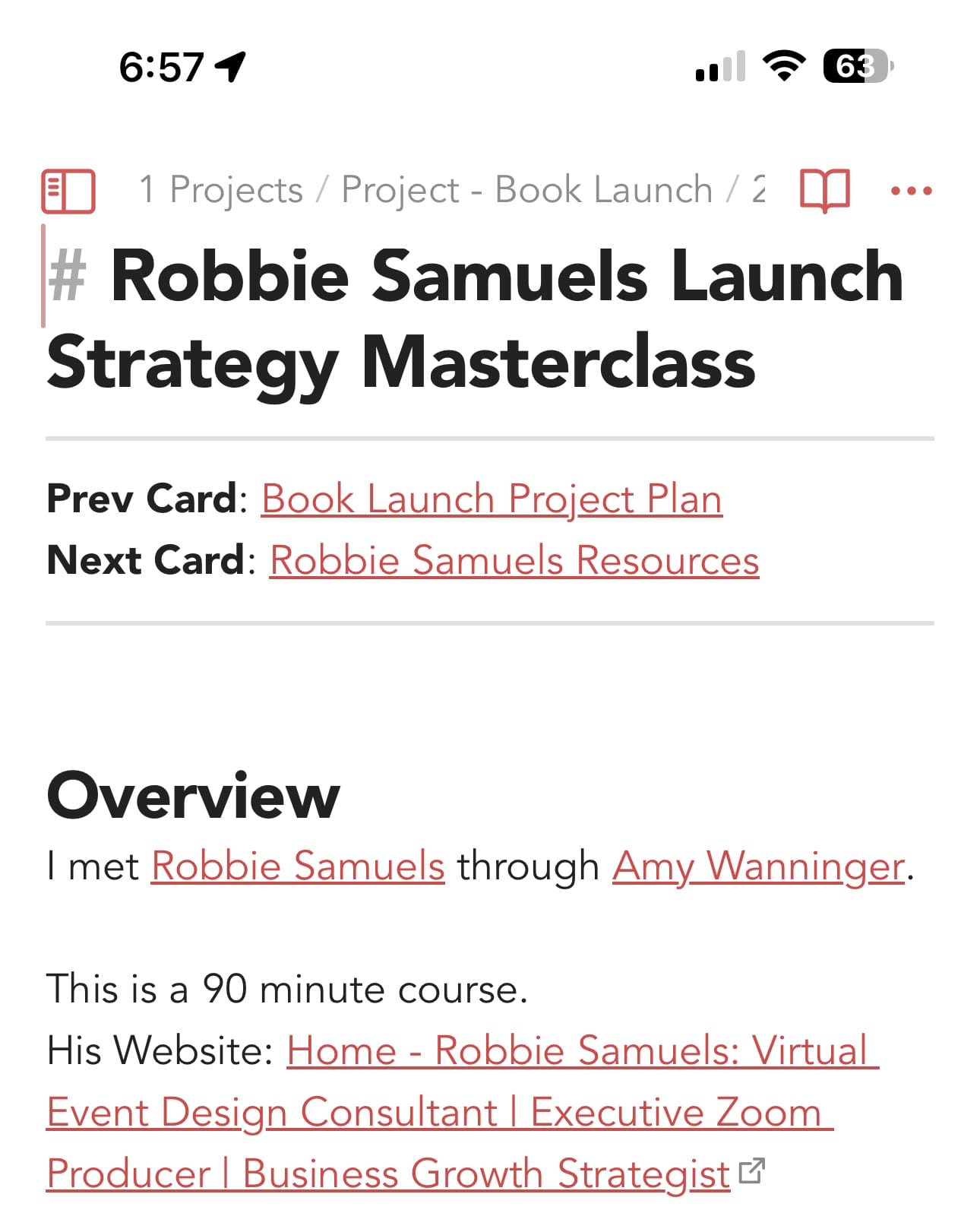I have given you the thinking behind my project template. I have even explained the technical details of how the template is put together, and how I use Dataview to create a better file list in my "home note."
But how do I actually use it?
Starting Thought Trains
For me projects almost always begin with research. I ask questions. Where do I put the answers? Most often, in Branch Notes. I also sometimes call notes "cards" (I think of them as big index cards).
This screen grab shows how I filled out my current project.

For example, my example project was how to do a book launch. So the first thing I did was reach out to my network and ask for recommendations. Three came back. Robbie Samuels, Don Williams, and Amber Vilhauer. I immediately add a note to my project to contain this information.
Using PeopleCards
Usually people will do an introductory email - and sometimes I capture those, but usually I'm after the contact information. I have another template I call "PeopleCard Template" and when I get to know a person I start a separate note for them. I learned this from good friend Chris Roth who keeps notes (in his Evernote!) Of all his friends, their likes, dislikes, families, and so on. It might sound a little weird, but it enables Chris to be one of the most thoughtful and considerate guys I know. Which says something because he is a genius chief financial officer.
He uses notes to balance his brilliant analytical mind. That to me is genius.

So I end up with two notes. One about the Person, and one about the Topic. This can turn out to be invaluable. For example, it turns out Amber Vilhauer was a speaker we hired for our chapter to do a virtual event on personal branding. She also offers a book launch service. So I discover I already have some great notes about Amber.
As I setup interviews with each person, (mostly video calls), I will open Obsidian and take notes during the call. But here's the trick, I create that "BranchCard" in my home note, put the information from the call into that note. I link that note to the personal card using the [[]] methodology. Now, there is a link between the topic, and the person and it goes in both directions. In the future, for example I could pull up Amber's card and see both projects we worked on together.
Branching with StartCards
When I start a new Branch I give it a special tag, "StartCard", so I know it's the head of a thought train. Then, I begin to put information into that first card.
There's almost always a staggering amount of information I learn during the call. I could use Otter.ai, or Fireflies.ai, or some other tool (and I have), and if I did I would copy that transcript into a new Note that links to my hand taken notes. This is the Next Card: link. As I have more conversations, I "tack on" more notes, to this thread.
Here's an example. I met Robbie Samuels through Amy Waninger. I created a StarCard note train in my projects plan, and a people card for Robbie. On our first call, he gave me a ton of information. I could have (but didn't) done a lot of research on Robbie, like find him on social media, research his website, look for his books on Amazon - all of that would go into his PeopleCard. And I can still do it in the future.
After our call, Robbie sent me some resources to consider, including a PDF. Guess where I put those? On a new NoteCard that followed the note that held my initial meeting.
Atomic Ideas
I hope you're beginning to see a pattern. As I move through time, collecting information, I connect notes together in a chain. I use Templater Macros to make my life easier (I'll explain those in the future) but what I end up with is this "thread of thoughts" or you could call it a "thought train."

These threads become exceptionally powerful when a meeting, or a resource causes me to do more research. I can create new branches to capture that new information.
Why so many notes? Why note just one big giant file? This was Lumens genius insight. Ideas are building blocks and over time they will connect to other ideas in surprising ways. When you lump everything into one giant file you lose the ability to form these kinds of connections. And insights, are by definition, when you connect two seemingly unrelated things. Or you connect two things in ways they have not been connected before.
Every time you connect a new idea to something you already know, you dramatically increase the availability of that idea in your head. It also makes that idea more discoverable in your notes.
James Clear talked about Atomic Habits. I want to think in Atomic Ideas. My NoteCards are the "lego bricks" I build new ideas, and new understanding from.
Absolutely not. This is what I do. This works for me. It is a collection of best practices I have gathered. Does it take time? Yes, but so does looking for scattered, lost, or forgotten information. The pay off is that I can step back into any project and be immediately productive fast.
Daily Note To the Rescue
You may notice that I mentioned three people, but only two are listed in my project. Sometimes, I'm in a hurry and I don't get this setup the way I want. No problem. My fall back is always the daily note. When I spoke to Don Williams I just pulled up my daily note, dropped in his name, and started typing notes.
Eventually, I will go back and pull his information into this project. The beauty of the system is that I always have a place to put things. And if I miss something - I know where to find it. In fact, after I post this article, I'll pull the notes from my conversation with Don into my Book Launch project.
Summary
You may be thinking that is a lot of work. I have learned this is considerably less work than digging through emails, WhatsApp messages, LinkedIn and files scattered around my hard drive by having a repository for all information I gather on a project. When it really pays off is when it comes time to act. Everything I need is at my finger tips. Also, when I take a break - I might go 1-2 weeks between project touches. This system, like meeting up with an old friend lets me dive back in like no time had passed.




